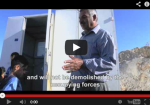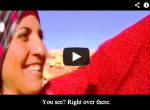You are currently browsing the tag archive for the ‘demolition’ tag.
In this post we accompany the children of the Shuneran family on their daily chore of shepherding and sheep grazing. One must remember that the area where Susya is located is an arid area, which makes it difficult for the farmers to maintain their livestock. Given that the people in Susya are not connected to the water infrastructure, they and their livestock are dependent on water from cisterns. However, the cisterns are often being deliberately polluted and/or permanently damaged, apparently by settlers from nearby settlements. Due to the scant precipitation in the area, the water accumulated in the cisterns does not last for the entire year. Therefore, the people in Susya have to buy their water from Israeli settlements, such as Kiryat Arba.
In the video Fariha relates that the settlers used to hassle the local residents even when she was a little girl, but the harassments have worsened in the past few years. Alhough the children in Susya behave with much more maturity than one would expect from children their age because they need to take care of their family’s livestock, work in the field, and maintain the household, they are still kids with dreams, hobbies, hopes, and aspirations. The settlers’ violence and the political situation in the area prevents Susya’s children from following their dreams and fulfilling themselves, because they bear such responsibility for the welfare of their families.
Watch: Not Connected to the Water Infrastructure
Act Now!
Help us prevent Susya from being wiped out.
- Spread word of the injustice;
- Write to Israel’s President Shimon Peres (Sample letter and email below), demanding that this moral stain in our name be prevented. President Peres cannot and should not interfere with the legal process. However, if we meet our goal of 2400 letters in the next 24 hours we may be able to generated some much needed publicity before the hearing, and influence what President Peres does after the hearing.
Write to President Shimon Peres:
Email: President of the state of Israel Mr. Shimon Peres: public@president.gov.il
Fax: +972-2-5887225
Please send copies of all emails and faxes, as well as any responses you receive, to RHR at info@rhr.israel.net
Subject: Please use your power to prevent the injustice of wiping out the entire Palestinian village of Susya
Dear Mr. President
Please use your power to prevent the injustice of wiping out the entire Palestinian village of Susya, whose only offense is building for its own survival. The villagers have they been forced to build their flimsy homes on their farmland only because they have been twice expelled from their homes by the IDF.
Background: The Palestinian village Susya is located in the South Hebron Hills, one of the poorest, disempowered areas in the entire West Bank. It is one of several small communities in the region that are part of a unique culture living until this day in caves. Susya consists mainly of tents and the few remaining caves not destroyed, with no electricity, water or sewage infrastructure. The residents barely subsist on seasonal agriculture and herding. The attempt to force these simple people off their lands has been likened to the kivsat harash,
Susya is located on its residents’ farmland, for which they have no construction permits. They didn’t move there to flout the law. Rather, they were expelled from their previous homes. Many of the residents originally lived just on the Israeli side of the 1967 border, but joined family members in the original village of Susya after being expelled into the West Bank in 1948. In 1986 the Susya was declared a closed archaeological zone because an ancient Hebrew synagogue had been unearthed there. The Palestinians were expelled from their village without receiving any alternative accommodations. They moved to a different set of caves on their farmland.
In 2001 all the villagers were again expelled, this time from their farmland. Again, the army destroyed the caves in which they lived. The reason: A settler from the adjacent settlement of Susya had been murdered. The killer eventually apprehended was from the town of Yatta, but that didn’t stop the army from destroying all of Susya. The idea of collective punishment – of punishing an entire village for the offenses of one person – is distorted, destructive and unlawful to begin with. But, in the case of Susya, the punishment was meted out to a village that had nothing to do with the murder.
The Israeli High Court ruled that demolitions must stop, and the residents must be permitted to return. Because the caves had been destroyed, the Susya residents were forced to build tin shanties and tents. However, planning for Palestinians in the Occupied Territories has been controlled by the military since 1971, without Palestinian representation. The planning committees were unprepared to even approve the construction needed to replace the caves illegally demolished by the army. Demolition orders have been issued for all structures in the village from 2001 until today. Recently, the extremist organization Regavim petitioned the court to expedite the carrying out of outstanding demolition orders. The entire village is in peril.
This Thursday, January 31st, a fateful High Court hearing on the Regavim petition will take place. It will not only determine Susya’s future, but will have implications for endangered homes throughout the Occupied Territories. We are cautiously optimistic that the Court will not approve Regavim’s request, because the Court will probably accept the State’s position that demolitions cannot be carried out before due consideration has been given to a new alternative zoning plan that has submitted by Rabbis For Human Rights. However, if the Court merely accepts the State position, we leave in place the discriminatory planning system denying Susya and other Palestinian communities any possibility of even minimum humanitarian development. In all likelihood, the Civil Administration will eventually reject the new zoning plan, and Susya will be again in danger.
First and foremost, this terribly unjust. Please take to heart the Torah’s oft repeated command to remember the bitterness of Egyptian oppression when we relate to the strangers in our midst. Furthermore, the hatred and misery created by planning discrimination and administrative demolitions make the dream of peace and security ever more distant, and further erode Israel’s standing in the community of nations.
We know that you cannot and should not interfere in judicial decisions. However, you can use your influence to persuade the new Israeli government to end the intentionally discriminatory planning process for Palestinians in Area C, and you can work for a moratorium on administrative home demolitions until such time as a more just system is in place.
Sincerely,
Your name
Background: The Palestinian village Susya is located in the South Hebron Hills, one of the poorest, disempowered areas in the entire West Bank. It is one of several small communities in the region that are part of a unique culture living until this day in caves. Susya consists mainly of tents and the few remaining caves not destroyed, with no electricity, water or sewage infrastructure. The residents barely subsist on seasonal agriculture and herding. The attempt to force these simple people off their lands has been likened to the kivsat harash, the Biblical parable of a wealthy man who steals the one ewe lamb of a poor man. The prophet Nathan uses this story to rebuke King David.
Susya is located on its residents’ farmland, for which they have no construction permits. They didn’t move there to flout the law. Rather, they were expelled from their previous homes. Many of the residents originally lived just on the Israeli side of the 1967 border, but joined family members in the original village of Susya after being expelled into the West Bank in 1948. In 1986 the Susya was declared a closed archaeological zone because an ancient Hebrew synagogue had been unearthed there. The Palestinians were expelled from their village without receiving any alternative accommodations. They moved to a different set of caves on their farmland.
In 2001 all the villagers were again expelled, this time from their farmland. Again, the army destroyed the caves in which they lived. The reason: A settler from the adjacent settlement of Susya had been murdered. The killer eventually apprehended was from the town of Yatta, but that didn’t stop the army from destroying all of Susya. The idea of collective punishment – of punishing an entire village for the offenses of one person – is distorted, destructive and unlawful to begin with. But, in the case of Susya, the punishment was meted out to a village that had nothing to do with the murder.
The Israeli High Court ruled that demolitions must stop, and the residents must be permitted to return. Because the caves had been destroyed, the Susya residents were forced to build tin shanties and tents. However, planning for Palestinians in the Occupied Territories has been controlled by the military since 1971, without Palestinian representation. The planning committees were unprepared to even approve the construction needed to replace the caves illegally demolished by the army. Demolition orders have been issued for all structures in the village from 2001 until today. Recently, the extremist organization Regavim petitioned the court to expedite the carrying out of outstanding demolition orders. The entire village is in peril.
On Thursday, January 31st, a fateful Supreme Court hearing on the Regavim petition will take place. It will not only determine Susya’s future, but will have implications for endangered homes throughout the Occupied Territories. We are cautiously optimistic that the Court will not approve Regavim’s request, because even the State has said that demolitions cannot be carried out before due consideration has been given to a new alternative zoning plan RHR has submitted, that would legalize the homes and school and solar panels of Susya. However, if the Court merely accepts the State position, we leave in place the discriminatory planning system denying Susya and other Palestinian communities any possibility of even minimum humanitarian development.
We must spread the word regarding this injustice, and the desecration of God’s Name that could take place -In our name. We cannot let our country act toward the stranger in our midst in such a way that we forget our heritage. We were slaves in Egypt, and we have been commanded to remember the bitter taste of oppression.
For more information: The origin of the expulsion – A Brief history of Palestinian Susya
Please join us in the High Court on This Thursday (31.1) at 11:30 in order to Save Susya!
This video will introduce Susya’s elementary school, which was established four years ago and has been under the constant threat of demolition. The pending demolition orders issued by the Israeli Civil Administration (The branch of the Israeli army that deals with civilian affairs.) put at risk the basic right to education for dozens of young students, and threaten to destroy years of hard work carried out by devoted teachers. The school offers the first stage of education for children between the ages of 6-11 (Sometimes children attend even when they are older, as they cannot afford to continue their education elsewhere). The school is run by the principal, Muhammad Abu Jaber, and four teachers. The faculty members and the principal are also responsible for the maintenance of the school. Because educational alternatives are very distant and require families to pay for transportation, the existence of this school is critical to the lives of the younger generation of Susya.





